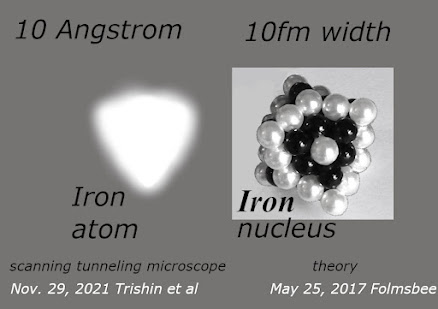White protons and dark neutrons
The triangular iron atom's blurry photo is like the original in Physical Review Letters. It is linked here: iron triangles photo. This proves that the theory reflects reality. The Static Nucleus Theory of the Face Armored Cubic Lattice is the correct description of nuclear structure for iron, and apparently, for all elements. A cube has six faces. Three faces in iron's cube make the North pole of a bar magnet. Three faces of the cube make the South pole. A triangular atom is seen with a microscope because a North pole has three pyramidal tips that cover three faces of a cube. The cubic stack of baryons has 27 baryons in iron (8 protons and 19 neutrons).
See nuclear-data.com from 2024
Power point slides of all 19 book covers and carbon poster session APS-2022 New York City
White protons and dark neutrons in those PowerPoint slide shows from October 25, 2023.
Iron is ferromagnetic because it has two coaxial rings of protons. Each ring has 12 protons.
The red lattice is made of protons and neutrons, in Fig. 1 .
The silhouettes of all elements are shown for a theory using a static nucleus.
The static nucleus theory asserts that spherical nucleons are stacked into fixed places for each element. This is not a dynamic structure, each nucleus keeps its face armored cubic structure permanently.
Notice that a separation of columns in the table highlights that elements on the right side of the table are all diamagnetic. The rightmost 8 groups are diamagnetic for periods 4 through 7. (Period 7 is in doubt in some sources. May 30, 2021).
2/28/2020 acf
See my paper in the Journal of Nuclear Physics, March, 2019.
"Magnetism from iron's nuclear structure"
http://www.journal-of-nuclear-physics.com/?m=201903
My wrings on chromium are in my
Read my Books:
Charge Distribution
The chemists are interested in the charge distribution in the nucleus and in the electron allocations far from the nucleus. The Periodic Table here shows the 18 foundation elements and the many elements that are built upon those. The foundation elements in the Table have protons distributed and neutrons distributed into a cubic lattice and into places that cover the six faces of each cube. That is an armor layer to allow the cube to survive permanently. That face armored cubic arrangement is the most stable static charge distribution and neutron distribution. To understand the charge distribution in any element, the Table is the place to start because the silhouette of the nucleus is defined. That foundational shape is used to see where each proton goes.The proton charge distribution for iron was discovered first. The images are abundant here to show that charge distribution. The Rules for charge distribution are given in the paper in
A summary of Rules of Proton Charge Distribution
In the simple cubic lattice, protons are placed far from each other as if Coulomb Repulsion were the rule.
Outside of the cubic lattice, protons tend to form lines of protons.
Photos of Charge Distribution
Theses links are for the Elements...
Carbon Argon Chromium
Fe Gd W U Fo Tc Hg Zr Ce Mn Cu Ni Co Nh
Hg
Po Nh
In the iron paper are the elements: Gd Fe Cu Co Ni Zr Tc Hg U Ne
2017 iron discovery blog, May 25, 2017 !!!!
Platinum catalyst blog page shows charge distribution
Here is a link to 3D CAD models (Computer Aided Design) for elements:
thingiverse Elements argon, thorium, radon, oganesson, polonium,
promethium, krypton, neon, carbon-12, carbon-13, lithium,
copper, iron, nickel.
youtube video of charge distribution of elements...
vanadium, barium, carbon nickel copper, Tc, nihonium,
zirconium, gadolinium, platinum.
6/7/2020
In Fig. 1, each element shows a top pyramid on a cube and a bottom pyramid that can be a different size. The silhouette of the nucleus shows two side pyramids are equal and does not show the front and back pyramids because they are the same as all side pyramids. All four side pyramids have equal size in all foundation elements in The Periodic Table of the Shape of Each Nucleus.
The Pyramidal Cube Theory of the Shape of Each Nucleus
Each nucleus of an element heavier than boron has a cube of baryons at its center. The faces of the cube are covered by pyramids of baryons. Carbon has a cube 2x2x2. Iron has a cube 3x3x3. Technetium has a cube 4x4x4. The shapes of the nuclei correspond to most properties of the elements. Iron's ferromagnetism is caused by the shape of the Fe nucleus, with two loops of protons that are coaxial. Elements have pyramids that feature lines of protons. The cube can have a checkerboard allocation of protons, or a sparse allocation of the positions of protons in a matrix of neutrons.
Links
2018 Nihonium nucleus : https://impuremath.wordpress.com/2017 summer periodic table: http://pyramidalcube.blogspot.com/2017/08/periodic-table-of-shapes-of-nuclei.html
2017 spring iron 2 loops : http://ferronuclear.blogspot.com/p/uranium.html
2016 gravito-Maxwell : http://traction8d.blogspot.com/p/iron-56_30.html
2015 5ns constant : http://fcontinuumgravity.blogspot.com/p/research-planning.html
2014 gravity : http://fcgravity.blogspot.com/
October 16, 2014 began the discoveries by Alan Folmsbee
youtube has 28 videos in my channel, 11/5/19 and
https://www.youtube.com/channel/UCKMzn4jBbjLFeUm4i0U354g
The Journal of Nuclear Physics has my paper on iron in the March, 2019 issue.
http://www.journal-of-nuclear-physics.com/?m=201903
Thingiverse has 3D models you can download,
https://www.thingiverse.com/GlobeMaker/designs
go to top menu














Get chemistry notes from here: Periodic Table | SEE Class 10 | Chemistry Notes
ReplyDelete